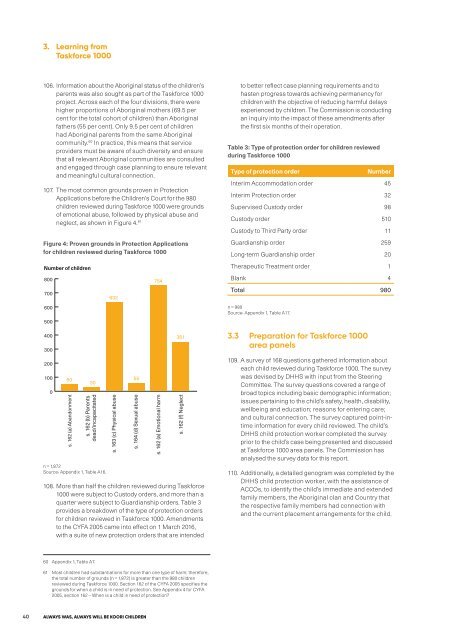ALWAYS WAS ALWAYS WILL BE KOORI CHILDREN
2dHjhRC
2dHjhRC
Create successful ePaper yourself
Turn your PDF publications into a flip-book with our unique Google optimized e-Paper software.
3. Learning from<br />
Taskforce 1000<br />
106. Information about the Aboriginal status of the children’s<br />
parents was also sought as part of the Taskforce 1000<br />
project. Across each of the four divisions, there were<br />
higher proportions of Aboriginal mothers (69.5 per<br />
cent for the total cohort of children) than Aboriginal<br />
fathers (55 per cent). Only 9.5 per cent of children<br />
had Aboriginal parents from the same Aboriginal<br />
community. 60 In practice, this means that service<br />
providers must be aware of such diversity and ensure<br />
that all relevant Aboriginal communities are consulted<br />
and engaged through case planning to ensure relevant<br />
and meaningful cultural connection.<br />
107. The most common grounds proven in Protection<br />
Applications before the Children’s Court for the 980<br />
children reviewed during Taskforce 1000 were grounds<br />
of emotional abuse, followed by physical abuse and<br />
neglect, as shown in Figure 4. 61<br />
Figure 4: Proven grounds in Protection Applications<br />
for children reviewed during Taskforce 1000<br />
Number of children<br />
800<br />
700<br />
600<br />
500<br />
400<br />
300<br />
200<br />
100<br />
0<br />
50<br />
s. 162 (a) Abandonment<br />
30<br />
s. 162 (b) Parents<br />
dead/incapacitated<br />
n = 1,872<br />
Source: Appendix 1, Table A16.<br />
632<br />
s. 163 (c) Physical abuse<br />
108. More than half the children reviewed during Taskforce<br />
1000 were subject to Custody orders, and more than a<br />
quarter were subject to Guardianship orders. Table 3<br />
provides a breakdown of the type of protection orders<br />
for children reviewed in Taskforce 1000. Amendments<br />
to the CYFA 2005 came into effect on 1 March 2016,<br />
with a suite of new protection orders that are intended<br />
55<br />
s. 164 (d) Sexual abuse<br />
754<br />
s. 162 (a) Emotional harm<br />
351<br />
s. 162 (f) Neglect<br />
to better reflect case planning requirements and to<br />
hasten progress towards achieving permanency for<br />
children with the objective of reducing harmful delays<br />
experienced by children. The Commission is conducting<br />
an inquiry into the impact of these amendments after<br />
the first six months of their operation.<br />
Table 3: Type of protection order for children reviewed<br />
during Taskforce 1000<br />
Type of protection order<br />
Number<br />
Interim Accommodation order 45<br />
Interim Protection order 32<br />
Supervised Custody order 98<br />
Custody order 510<br />
Custody to Third Party order 11<br />
Guardianship order 259<br />
Long-term Guardianship order 20<br />
Therapeutic Treatment order 1<br />
Blank 4<br />
Total 980<br />
n = 980<br />
Source: Appendix 1, Table A17.<br />
3.3 Preparation for Taskforce 1000<br />
area panels<br />
109. A survey of 168 questions gathered information about<br />
each child reviewed during Taskforce 1000. The survey<br />
was devised by DHHS with input from the Steering<br />
Committee. The survey questions covered a range of<br />
broad topics including basic demographic information;<br />
issues pertaining to the child’s safety, health, disability,<br />
wellbeing and education; reasons for entering care;<br />
and cultural connection. The survey captured point-intime<br />
information for every child reviewed. The child’s<br />
DHHS child protection worker completed the survey<br />
prior to the child’s case being presented and discussed<br />
at Taskforce 1000 area panels. The Commission has<br />
analysed the survey data for this report.<br />
110. Additionally, a detailed genogram was completed by the<br />
DHHS child protection worker, with the assistance of<br />
ACCOs, to identify the child’s immediate and extended<br />
family members, the Aboriginal clan and Country that<br />
the respective family members had connection with<br />
and the current placement arrangements for the child.<br />
60 Appendix 1, Table A7.<br />
61 Most children had substantiations for more than one type of harm; therefore,<br />
the total number of grounds (n = 1,872) is greater than the 980 children<br />
reviewed during Taskforce 1000. Section 162 of the CYFA 2005 specifies the<br />
grounds for when a child is in need of protection. See Appendix 4 for CYFA<br />
2005, section 162 – When is a child in need of protection?<br />
40 <strong>ALWAYS</strong> <strong>WAS</strong>, <strong>ALWAYS</strong> <strong>WILL</strong> <strong>BE</strong> <strong>KOORI</strong> <strong>CHILDREN</strong>


